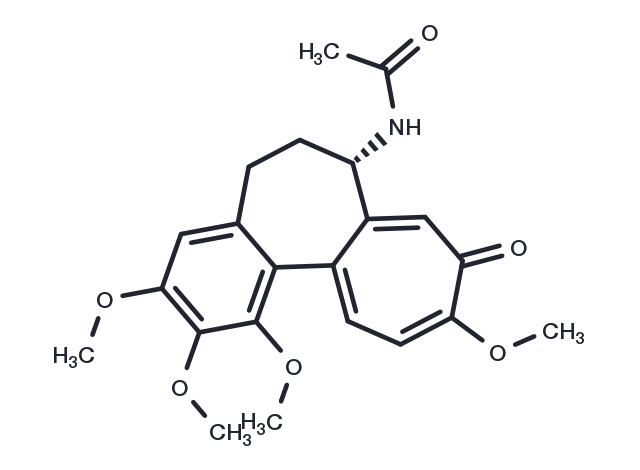keep away from direct sunlight
Powder: -20°C for 3 years | In solvent: -80°C for 1 year
Colchicine (Colcin) is a natural product that is an inhibitor of microtubule polymerization (IC50=3 nM) and blocks microtubule polymerization by binding to microtubule proteins. Colchicine can be used in the treatment of ventilation and rheumatic diseases.

| パッケージサイズ | 在庫状況 | 単価(税別) | |||
|---|---|---|---|---|---|
| サンプルについてお問い合わせ | |||||
| 100 mg | お問い合わせ | ¥ 8,000 | |||
| 200 mg | お問い合わせ | ¥ 11,500 | |||
| 500 mg | お問い合わせ | ¥ 15,000 | |||
| 1 mL * 10 mM (in DMSO) | 在庫あり | ¥ 11,500 | |||
| 説明 | Colchicine (Colcin) is a natural product that is an inhibitor of microtubule polymerization (IC50=3 nM) and blocks microtubule polymerization by binding to microtubule proteins. Colchicine can be used in the treatment of ventilation and rheumatic diseases. |
| ターゲット&IC50 | Microtubule:3 nM |
| In vitro |
METHODS: Human pharyngeal carcinoma cells FaDu and SNU1041 were treated with Colchicine (0.0-1 μM) for 24-72 h. Cell viability was measured by XTT assay. RESULTS: Colchicine treatment was cytotoxic to both FaDu and SNU1041 cell lines in a dose- and time-dependent manner. [1] METHODS: Chorionic villous cells AFCs and amniotic fluid cells CVCs were treated with Colchicine (0.15 μg/mL) for 3-24 h. Apoptosis was detected by Flow Cytometry. RESULTS: Colchicine induced a significant increase in the proportion of annexin V and PI double positive cells. [2] |
| In vivo |
METHODS: To investigate the antitumor activity, Colchicine (0.1 mg/kg) was orally administered to BALB/c-nu mice bearing the human pharyngeal cancer tumor FaDu every two days for fourteen days. RESULTS: Colchicine was effective in inhibiting tumor growth in a hypopharyngeal cancer model nude mouse without serious complications. [1] METHODS: To investigate the effect of anti-Fas antibody-induced lethality, Colchicine (2 mg/kg) was injected intraperitoneally into C57BL/6 mice, followed by Jo2 antibody (10 μg) 24 h later. RESULTS: All mice treated with Colchicine survived the lethal attack.Colchicine reduced the susceptibility of mice to the lethal effect of Jo2 against Fas antibody. [3] |
| 動物実験 | a C57BL/6 background are used. To examine the effects of Colchicine on NSAID-induced small intestinal injury, vehicle or Colchicine (1 or 3 mg/kg) is administered orally 30 min prior to indomethacin administration. Mice received intraperitoneal injections of sterilized phosphate buffered saline or mouse recombinant IL-1β (0.1 μg/kg) 3 h after indomethacin treatment. Vehicle or Colchicine (1 or 3 mg/kg) is also administered to NLRP3?/? mice before indomethacin administration. The lesion index is evaluated 24 h after indomethacin administration and examined mRNA and protein expression of inflammasome components 6 h after indomethacin administration. |
| 植物由来 |
| 別名 | Colcin, Colchineos, Colchisol |
| 分子量 | 399.44 |
| 分子式 | C22H25NO6 |
| CAS No. | 64-86-8 |
keep away from direct sunlight
Powder: -20°C for 3 years | In solvent: -80°C for 1 year
DMSO: 45 mg/mL (112.66 mM)
H2O: 1.33 mg/mL(3.34 mM), Sonication is recommended.
You can also refer to dose conversion for different animals. 詳細
bottom
Please see Inhibitor Handling Instructions for more frequently ask questions. Topics include: how to prepare stock solutions, how to store products, and cautions on cell-based assays & animal experiments, etc.
Colchicine 64-86-8 Apoptosis Autophagy Cytoskeletal Signaling Microtubule Associated Colcin inhibit Colchineos Microtubule/Tubulin Colchisol Inhibitor inhibitor
